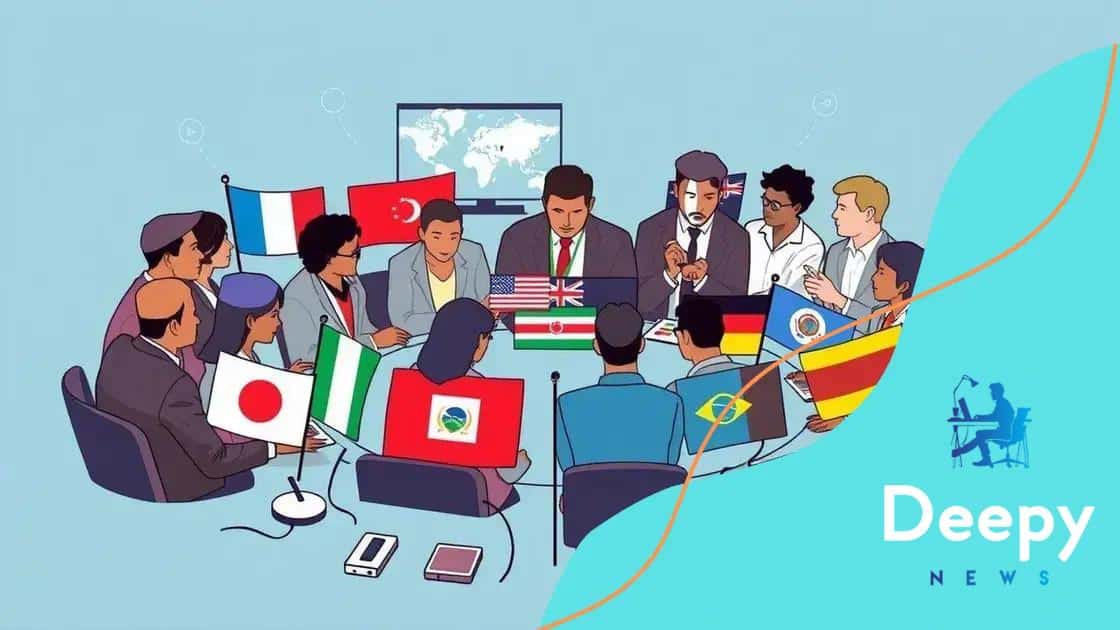Global efforts to tackle misinformation with AI

Global efforts to tackle misinformation with AI include advanced technologies that analyze data to identify false information, enhance digital literacy, and promote transparency among technology companies and users.
Global efforts to tackle misinformation with AI are increasingly significant in our fast-paced digital world. Have you ever wondered how tech can help us sift through the noise of false narratives? Let’s explore this pressing issue and the innovative solutions emerging today.
Understanding misinformation in the digital age
In the digital age, understanding misinformation is more important than ever. Misinformation can spread rapidly, affecting public perception and behavior. People often struggle to differentiate between credible information and falsehoods.
Understanding the types of misinformation is essential for navigating these challenges. This includes recognizing disinformation, which is intentionally false, and misinformation, which may be accidental.
Characteristics of Misinformation
Here are some key characteristics:
- Speed of Spread: Misinformation can go viral quickly through social media.
- Emotional Appeal: Content that triggers emotional responses is more likely to be shared.
- Source Credibility: Many people share information from sources they believe to be reliable.
Another important aspect is the role of algorithms. Social media platforms use algorithms to promote content, often prioritizing engagement over accuracy. This can lead to a greater focus on sensational stories, which may not be true.
Furthermore, understanding the impact of echo chambers is crucial. These are environments where people are exposed only to information that aligns with their beliefs. This can reinforce misinformation and make it harder for individuals to recognize contradictions.
Strategies for Identifying Misinformation
To combat misinformation, consider these strategies:
- Fact-Check Sources: Utilize fact-checking websites to verify claims.
- Analyze the Source: Check the credibility of the publication and author.
- Cross-Reference: Look for corroborating information from multiple sources.
Education is also vital. Teaching individuals how to critically evaluate the information they encounter helps build resilience against misinformation. Individuals can become more discerning consumers of content, making better-informed decisions based on credible information.
By understanding the landscape of misinformation in the digital age, we can take proactive steps to ensure that we are better informed and can navigate the complexities of information effectively.
The role of AI in identifying false information
The role of AI in identifying false information is becoming increasingly vital in our digital world. With the rapid spread of misinformation, artificial intelligence technologies are stepping in to help combat these challenges effectively.
AI systems are designed to analyze vast amounts of data quickly. They use algorithms to detect patterns that indicate misleading information. This ability allows them to flag potential falsehoods before they spread widely.
How AI Identifies False Information
AI can identify false information through various methods:
- Natural Language Processing (NLP): AI analyzes text for inconsistencies and biased language.
- Image Recognition: AI examines images for alterations or deepfakes.
- Data Analytics: AI looks at user behavior and engagement to spot suspicious activity.
These techniques contribute to a more informed public by curbing the reach of false narratives. AI tools can also summarize news articles and fact-check claims, reducing the time users spend verifying information.
In addition to identifying misinformation, AI can provide education on the significance of fact-checking. This ultimately empowers users to think critically. By understanding how misinformation spreads, people can become more discerning consumers of information.
The Impact of AI on Social Media
Social media platforms are harnessing AI to enhance their content moderation processes. Through these advancements, they can automatically flag and remove posts that violate community standards, helping to reduce the prevalence of misinformation.
Moreover, AI can improve user experience by promoting credible news sources. By analyzing user preferences, these systems can recommend trustworthy content that aligns with users’ interests.
Overall, AI plays a pivotal role in the fight against misinformation. As these technologies evolve, they will become even more effective at identifying and mitigating false information online. This ongoing progress is essential to maintaining a healthy information ecosystem in today’s technology-driven society.
Key global initiatives combating misinformation

Key global initiatives combating misinformation are essential to ensure accurate information flows in today’s digital landscape. Organizations, governments, and tech companies worldwide are taking significant steps to address this pressing issue.
One notable initiative is the International Fact-Checking Network (IFCN), which focuses on promoting transparency and collaboration among fact-checkers globally. This organization brings together fact-checking organizations to share resources and best practices.
Major Initiatives
Some of the major initiatives include:
- Facebook’s Third-Party Fact-Checking Program: This program collaborates with various fact-checking organizations to identify false news on its platform.
- The Trust Project: A global consortium aimed at creating transparency in journalism through indicators that help users gauge the credibility of news sources.
- WhatsApp’s Educational Campaigns: They provide users with tips on how to identify and avoid misinformation, thereby enhancing digital literacy.
Additionally, the European Union’s Code of Practice on Disinformation encourages online platforms to take responsibility for the content shared within their networks. It promotes actions to minimize the spread of false information and emphasizes collaboration between stakeholders.
Another significant effort is the United Nations’ initiative to tackle misinformation related to health, especially during crises like the COVID-19 pandemic. This initiative aims to promote accurate health information and counter false claims while building public trust.
Importance of Collaboration
Collaboration is vital in the fight against misinformation. By working together, countries and organizations can share valuable resources and approaches. Greater cooperation leads to more effective strategies in identifying and combating false information.
Through these key initiatives, a united approach is taken to mitigate the effects of misinformation globally. As new challenges arise, continuing to enhance these efforts will be crucial for maintaining an informed public.
How technology companies address misinformation
Technology companies play a crucial role in addressing misinformation in our digital world. Their platforms can amplify false information, making it essential for them to implement effective measures.
Many major tech companies have adopted comprehensive policies to combat false information, focusing on transparency and user education. By prioritizing credibility, they aim to foster a more informed user base.
Actions Taken by Technology Companies
Here are some key actions that these companies take:
- Content Moderation: Companies employ sophisticated algorithms and human reviewers to identify and remove misleading content.
- Collaboration with Fact-Checkers: Technology firms partner with independent fact-checking organizations to verify claims circulating on their platforms.
- User Reporting Tools: Many platforms have features that allow users to flag potentially false information for review.
These initiatives are designed to create a safer online environment. For instance, websites like Twitter and Facebook frequently update their community standards to increase accountability.
Moreover, technology companies focus on user education. They launch campaigns that provide guidance on how to identify credible sources. These efforts help users become more critical consumers of content, enabling them to discern facts from fiction.
Challenges Faced by Companies
Despite their best efforts, tech companies face various challenges in the fight against misinformation. One major issue is the sheer volume of content generated daily. This makes it difficult to monitor and manage all posts effectively.
Another challenge is the evolving nature of misinformation itself. As new trends emerge, so do techniques for spreading falsehoods, which require companies to adapt constantly. Staying ahead of misleading narratives is an ongoing battle.
In conclusion, technology companies are essential players in addressing misinformation. By implementing proactive measures, they strive to create a digital landscape where users can trust the information they consume.
Challenges and future trends in AI and misinformation
Challenges and future trends in AI and misinformation are significant topics in today’s information age. As technology evolves, so do the tactics used to spread misinformation, presenting new hurdles for both AI and society.
One major challenge is the rapid pace at which misinformation can spread across social media platforms. With billions of users, platforms face the daunting task of monitoring content effectively. This volume creates a need for advanced AI systems that can learn quickly and adapt to new forms of deception.
Key Challenges
Here are some key challenges that AI faces in combating misinformation:
- Adversarial Techniques: Spreaders of misinformation often use clever tactics to evade detection, such as altering text or images in subtle ways that confuse AI algorithms.
- Context Understanding: AI can struggle with context. Sometimes, a statement may be true in one context but misleading in another.
- Data Bias: If AI systems are trained on biased datasets, they may also inherit these biases, leading to incorrect assessments of information.
These challenges highlight the importance of ongoing research and development. As AI systems become more sophisticated, they must also be more capable of understanding nuances in language and context.
Future Trends
Looking ahead, several trends may shape how AI addresses misinformation:
- Improved Natural Language Processing: Advances in NLP will allow AI to understand the sentiment and meaning behind text better, making it more effective at detecting misinformation.
- Real-Time Monitoring Systems: Implementing real-time systems that can flag misinformation as it spreads can help mitigate its impact.
- Collaboration with Researchers: Collaborative efforts between tech companies and researchers can enhance the reliability of AI tools, allowing them to evolve in response to emerging misinformation tactics.
AI technology is likely to become an indispensable tool in identifying and addressing misinformation. As researchers and developers continue to refine these systems, we can hope for a future where accurate information prevails. Engaging users in education and critical thinking will complement AI efforts, fostering a more informed society.
FAQ – Frequently Asked Questions about AI and Misinformation
What role does AI play in combating misinformation?
AI helps identify and flag false information by analyzing data and detecting patterns indicative of misinformation.
How can technology companies address misinformation?
They can implement content moderation, partner with fact-checkers, and promote user education about credible sources.
What are the main challenges facing AI in this field?
AI faces challenges like handling vast data volumes, understanding context, and combating evolving misinformation tactics.
What future trends might influence the fight against misinformation?
Trends include improved natural language processing, real-time monitoring systems, and increased collaboration with researchers.






